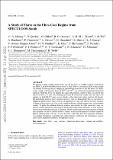A Study of Flares in the Ultra-Cool Regime from SPECULOOS-South
Author(s)
Murray, CA; Queloz, D; Gillon, M; Demory, BO; Triaud, AHMJ; de Wit, J; Burdanov, A; Chinchilla, P; Delrez, L; Dransfield, G; Ducrot, E; Garcia, LJ; Chew, Y Gómez Maqueo; Günther, MN; Jehin, E; McCormac, J; Niraula, P; Pedersen, PP; Pozuelos, FJ; Rackham, BV; Schanche, N; Sebastian, D; Thompson, SJ; Timmermans, M; Wells, R; ... Show more Show less
DownloadAccepted version (3.018Mb)
Open Access Policy
Open Access Policy
Creative Commons Attribution-Noncommercial-Share Alike
Terms of use
Metadata
Show full item recordAbstract
<jats:title>ABSTRACT</jats:title>
<jats:p>We present a study of photometric flares on 154 low-mass (≤0.2 M⊙) objects observed by the SPECULOOS-South Observatory from 2018 June 1 to 2020 March 23. In this sample, we identify 85 flaring objects, ranging in spectral type from M4 to L0. We detect 234 flares in this sample, with energies between 1029.2 and 1032.7 erg, using both automated and manual methods. With this work, we present the largest photometric sample of flares on late-M and ultra-cool dwarfs to date. By extending previous M dwarf flare studies into the ultra-cool regime, we find M5–M7 stars are more likely to flare than both earlier, and later, M dwarfs. By performing artificial flare injection-recovery tests, we demonstrate that we can detect a significant proportion of flares down to an amplitude of 1 per cent, and we are most sensitive to flares on the coolest stars. Our results reveal an absence of high-energy flares on the reddest dwarfs. To probe the relations between rotation and activity for fully convective stars, we extract rotation periods for fast rotators and lower-bound period estimates of slow rotators. These rotation periods span from 2.2 h to 65 d, and we find that the proportion of flaring stars increases for the most fastest rotators. Finally, we discuss the impact of our flare sample on planets orbiting ultra-cool stars. As stars become cooler, they flare less frequently; therefore, it is unlikely that planets around the most reddest dwarfs would enter the ‘abiogenesis’ zone or drive visible-light photosynthesis through flares alone.</jats:p>
Date issued
2022Department
Massachusetts Institute of Technology. Department of Earth, Atmospheric, and Planetary SciencesJournal
Monthly Notices of the Royal Astronomical Society
Publisher
Oxford University Press (OUP)
Citation
Murray, CA, Queloz, D, Gillon, M, Demory, BO, Triaud, AHMJ et al. 2022. "A Study of Flares in the Ultra-Cool Regime from SPECULOOS-South." Monthly Notices of the Royal Astronomical Society, 513 (2).
Version: Author's final manuscript